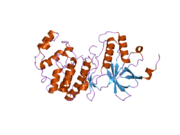MAPK13
| MAPK13 | |||||||||||||||||||||||||||||||||||||||||||||||||||
|---|---|---|---|---|---|---|---|---|---|---|---|---|---|---|---|---|---|---|---|---|---|---|---|---|---|---|---|---|---|---|---|---|---|---|---|---|---|---|---|---|---|---|---|---|---|---|---|---|---|---|---|
| |||||||||||||||||||||||||||||||||||||||||||||||||||
| Identifiers | |||||||||||||||||||||||||||||||||||||||||||||||||||
| Aliases | MAPK13, MAPK 13, MAPK-13, PRKM13, SAPK4, p38delta, mitogen-activated protein kinase 13 | ||||||||||||||||||||||||||||||||||||||||||||||||||
| External IDs | OMIM: 602899 MGI: 1346864 HomoloGene: 48133 GeneCards: MAPK13 | ||||||||||||||||||||||||||||||||||||||||||||||||||
| |||||||||||||||||||||||||||||||||||||||||||||||||||
| |||||||||||||||||||||||||||||||||||||||||||||||||||
| |||||||||||||||||||||||||||||||||||||||||||||||||||
| |||||||||||||||||||||||||||||||||||||||||||||||||||
| |||||||||||||||||||||||||||||||||||||||||||||||||||
| Wikidata | |||||||||||||||||||||||||||||||||||||||||||||||||||
| |||||||||||||||||||||||||||||||||||||||||||||||||||
Mitogen-activated protein kinase 13 (MAPK 13), also known as stress-activated protein kinase 4 (SAPK4), is an enzyme that in humans is encoded by the MAPK13 gene.[5]
Function
The protein encoded by this gene is a member of the MAP kinase family. MAP kinases act as an integration point for multiple biochemical signals, and are involved in a wide variety of cellular processes such as proliferation, differentiation, transcription regulation and development. This kinase is closely related to p38 MAP kinase, both of which can be activated by proinflammatory cytokines and cellular stress. MAP kinase kinases 3, and 6 can phosphorylate and activate this kinase. Transcription factor ATF2, and microtubule dynamics regulator stathmin have been shown to be the substrates of this kinase.[5]
References
- ^ a b c GRCh38: Ensembl release 89: ENSG00000156711 – Ensembl, May 2017
- ^ a b c GRCm38: Ensembl release 89: ENSMUSG00000004864 – Ensembl, May 2017
- ^ "Human PubMed Reference:". National Center for Biotechnology Information, U.S. National Library of Medicine.
- ^ "Mouse PubMed Reference:". National Center for Biotechnology Information, U.S. National Library of Medicine.
- ^ a b "Entrez Gene: mitogen-activated protein kinase 13".
Further reading
- Efimova T, Broome AM, Eckert RL (2004). "Protein kinase Cdelta regulates keratinocyte death and survival by regulating activity and subcellular localization of a p38delta-extracellular signal-regulated kinase 1/2 complex". Mol. Cell. Biol. 24 (18): 8167–83. doi:10.1128/MCB.24.18.8167-8183.2004. PMC 515052. PMID 15340077.
- Joneson T, Bar-Sagi D (1997). "Ras effectors and their role in mitogenesis and oncogenesis". J. Mol. Med. 75 (8): 587–93. doi:10.1007/s001090050143. PMID 9297626. S2CID 23541383.
- Efimova T (2010). "p38delta mitogen-activated protein kinase regulates skin homeostasis and tumorigenesis". Cell Cycle. 9 (3): 498–05. doi:10.4161/cc.9.3.10541. PMID 20090411.
- Gutierrez-Sanmartin D, Varela-Ledo E, Aguilera A, et al. (2008). "Implication of p38 mitogen-activated protein kinase isoforms (alpha, beta, gamma and delta) in CD4+ T-cell infection with human immunodeficiency virus type I." J. Gen. Virol. 89 (Pt 7): 1661–71. doi:10.1099/vir.0.82971-0. PMID 18559936.
- Zhang J, Harrison JS, Studzinski GP (2011). "Isoforms of p38MAPK gamma and delta contribute to differentiation of human AML cells induced by 1,25-dihydroxyvitamin D₃". Exp. Cell Res. 317 (1): 117–30. doi:10.1016/j.yexcr.2010.08.010. PMC 2998239. PMID 20804750.
- Segat L, Brandão LA, Guimarães RL, et al. (2010). "Polymorphisms in innate immunity genes and patients response to dendritic cell-based HIV immuno-treatment". Vaccine. 28 (10): 2201–6. doi:10.1016/j.vaccine.2009.12.056. PMID 20056178.
- Zhou X, Ferraris JD, Dmitrieva NI, et al. (2008). "MKP-1 inhibits high NaCl-induced activation of p38 but does not inhibit the activation of TonEBP/OREBP: opposite roles of p38alpha and p38delta". Proc. Natl. Acad. Sci. U.S.A. 105 (14): 5620–5. Bibcode:2008PNAS..105.5620Z. doi:10.1073/pnas.0801453105. PMC 2291081. PMID 18367666.
- Coulthard LR, Taylor JC, Eyre S, et al. (2011). "Genetic variants within the MAP kinase signalling network and anti-TNF treatment response in rheumatoid arthritis patients". Ann. Rheum. Dis. 70 (1): 98–103. doi:10.1136/ard.2010.133249. PMID 20805296. S2CID 37511360.
- Efimova T, Broome AM, Eckert RL (2003). "A regulatory role for p38 delta MAPK in keratinocyte differentiation. Evidence for p38 delta-ERK1/2 complex formation". J. Biol. Chem. 278 (36): 34277–85. doi:10.1074/jbc.M302759200. PMID 12810719.
- Kim SJ, Zhang Z, Hitomi E, et al. (2006). "Endoplasmic reticulum stress-induced caspase-4 activation mediates apoptosis and neurodegeneration in INCL". Hum. Mol. Genet. 15 (11): 1826–34. doi:10.1093/hmg/ddl105. PMID 16644870.
- Talmud PJ, Drenos F, Shah S, et al. (2009). "Gene-centric association signals for lipids and apolipoproteins identified via the HumanCVD BeadChip". Am. J. Hum. Genet. 85 (5): 628–42. doi:10.1016/j.ajhg.2009.10.014. PMC 2775832. PMID 19913121.
- Mungall AJ, Palmer SA, Sims SK, et al. (2003). "The DNA sequence and analysis of human chromosome 6". Nature. 425 (6960): 805–11. Bibcode:2003Natur.425..805M. doi:10.1038/nature02055. PMID 14574404.
- Colland F, Jacq X, Trouplin V, et al. (2004). "Functional proteomics mapping of a human signaling pathway". Genome Res. 14 (7): 1324–32. doi:10.1101/gr.2334104. PMC 442148. PMID 15231748.
- Gerhard DS, Wagner L, Feingold EA, et al. (2004). "The status, quality, and expansion of the NIH full-length cDNA project: the Mammalian Gene Collection (MGC)". Genome Res. 14 (10B): 2121–7. doi:10.1101/gr.2596504. PMC 528928. PMID 15489334.
- Ozawa S, Ito S, Kato Y, et al. (2010). "Human p38 delta MAP kinase mediates UV irradiation induced up-regulation of the gene expression of chemokine BRAK/CXCL14". Biochem. Biophys. Res. Commun. 396 (4): 1060–4. doi:10.1016/j.bbrc.2010.05.072. PMID 20478268.
- Kitatani K, Sheldon K, Anelli V, et al. (2009). "Acid beta-glucosidase 1 counteracts p38delta-dependent induction of interleukin-6: possible role for ceramide as an anti-inflammatory lipid". J. Biol. Chem. 284 (19): 12979–88. doi:10.1074/jbc.M809500200. PMC 2676030. PMID 19279008.
- Tan FL, Ooi A, Huang D, et al. (2010). "p38delta/MAPK13 as a diagnostic marker for cholangiocarcinoma and its involvement in cell motility and invasion". Int. J. Cancer. 126 (10): 2353–61. doi:10.1002/ijc.24944. PMID 19816939. S2CID 34276751.
- Sofroniew MV, Howe CL, Mobley WC (2001). "Nerve growth factor signaling, neuroprotection, and neural repair". Annu. Rev. Neurosci. 24: 1217–81. doi:10.1146/annurev.neuro.24.1.1217. PMID 11520933.
- Bailey SD, Xie C, Do R, et al. (2010). "Variation at the NFATC2 locus increases the risk of thiazolidinedione-induced edema in the Diabetes REduction Assessment with ramipril and rosiglitazone Medication (DREAM) study". Diabetes Care. 33 (10): 2250–3. doi:10.2337/dc10-0452. PMC 2945168. PMID 20628086.
- Sumara G, Formentini I, Collins S, et al. (2009). "Regulation of PKD by the MAPK p38delta in insulin secretion and glucose homeostasis". Cell. 136 (2): 235–48. doi:10.1016/j.cell.2008.11.018. PMC 2638021. PMID 19135240.
- v
- t
- e
-
 3coi: Crystal structure of p38delta kinase
3coi: Crystal structure of p38delta kinase
This article incorporates text from the United States National Library of Medicine, which is in the public domain.
 | This article on a gene on human chromosome 22 is a stub. You can help Wikipedia by expanding it. |
- v
- t
- e


















